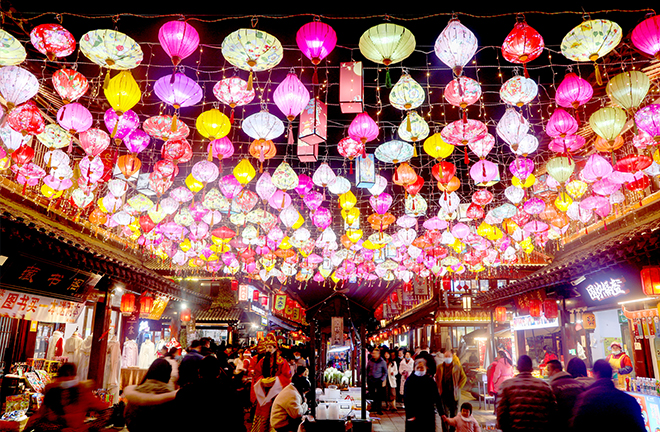Regaining urban vitality through renewal of historic street districts

The lantern tour at historic street districts in Ganzhou City, Jiangxi Province Photo: Liu Lixin/CNS
In 2021, the General Office of the CPC Central Committee and the General Office of the State Council jointly issued the Opinions on Strengthening the Protection and Inheritance of Historical and Cultural Heritage through Urban and Rural Development, which proposed to systematically protect, utilize, and inherit historical and cultural heritage. As public spaces with unique cultural attributes, historic street districts convey memories of the cities in which they are located and the social memory of residents. As a typical embodiment of urban diversity, they are also a special form of urban renewal.
Public attributes embodied
Historic street districts not only denote streets in cities, but also include communities where commercial, cultural, and social activities are integrated. As transportation corridors in cities, they are general public resources and carry public attributes. Yet, they also are a special type of target for primary-level community governance.
Their public attributes are mainly reflected in the following two aspects. First, historic street districts are not spaces belonging to individual people or specific groups, nor they are private domains. Rather, they are public spheres—spaces where multiple subjects function together and are influenced by local governments, enterprises, social organizations, and other forces.
Second, historic street districts are also common sites where people carry out functional or ceremonial activities, thus playing a crucial role in building social bonds. In the process of urbanization, large-scale urban renewal and spatial transformation are inevitable, which means the original layouts of urban environments will change and may even be destroyed to make way for progress. For this reason, it has become an urgent task to reshape urban public spaces so as to retain their social value and regain urban vitality.
Coordinated consultation needed
In the 1990s, historic street districts in China experienced large-scale demolition and reconstruction, which mostly followed a renewal mode with a top-down and administration-centered approach. It was later gradually replaced by co-construction mode with participation from multi-subjects. In the current development process, historic street districts are often developed in a way that is closely related to tourism.
Concretely speaking, the local government is the natural representative for local public interests, and this makes certain defects inescapable, such as a tendency towards “sectionalism” in goal setting, or a preference for efficiency over other factors. The participation from enterprises can play a coordinated role in mitigating interventions from local government in the development of historic street districts to certain degrees. While improving the cultural consumption environment and imparting vitality to commerce within these districts, enterprises can also help mobilize various market resources into the practice of jointly creating the public sphere. Definitely, there will also be potential impacts from marketization, which clearly erodes public attributes, and this is frequently castigated by scholars.
Renewal of historic street districts, which has been conducted with local governments and enterprises as the main actors, has made remarkable achievements in the past, but many problems have arisen. For instance, street district cultures are often disjointed from daily life. This is because festival activities there are decided by local governments and businesses, many of which are abstract cultural symbols, disconnected from the details of social life and not representative of on-the-ground practices. And residents and consumers are only passive recipients.
In short, when local governments and enterprises set the public interest target, they often miss the mark due to a lack of participation from members of local society. Local social forces usually include the general public and social organizations. Though their role increasingly valued, they are relatively weak actors. Therefore, we call for joint efforts and coordinated consultation from local governments, enterprises, social organizations, and residents in managing the public affairs of historic street district renewal. The goal is to make the complex urban renewal process dynamically balanced for more cities’ sustainable development.
Sun Fei and Yang Faxiang are from the School of Social and Public Administration at the East China University of Science and Technology.
Edited by BAI LE
